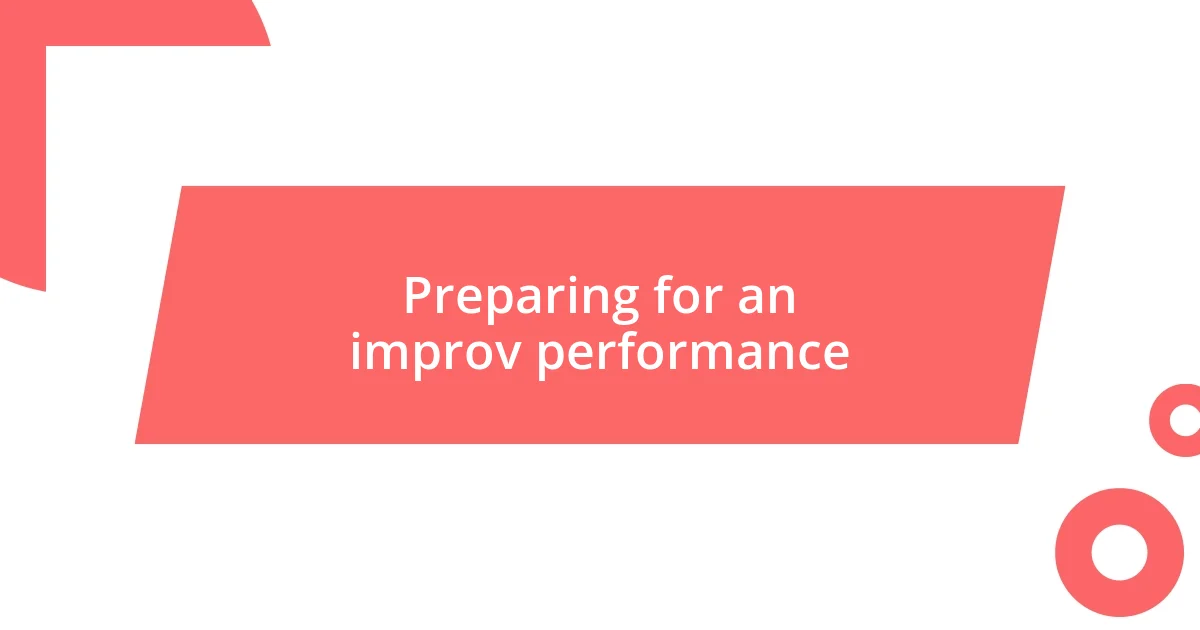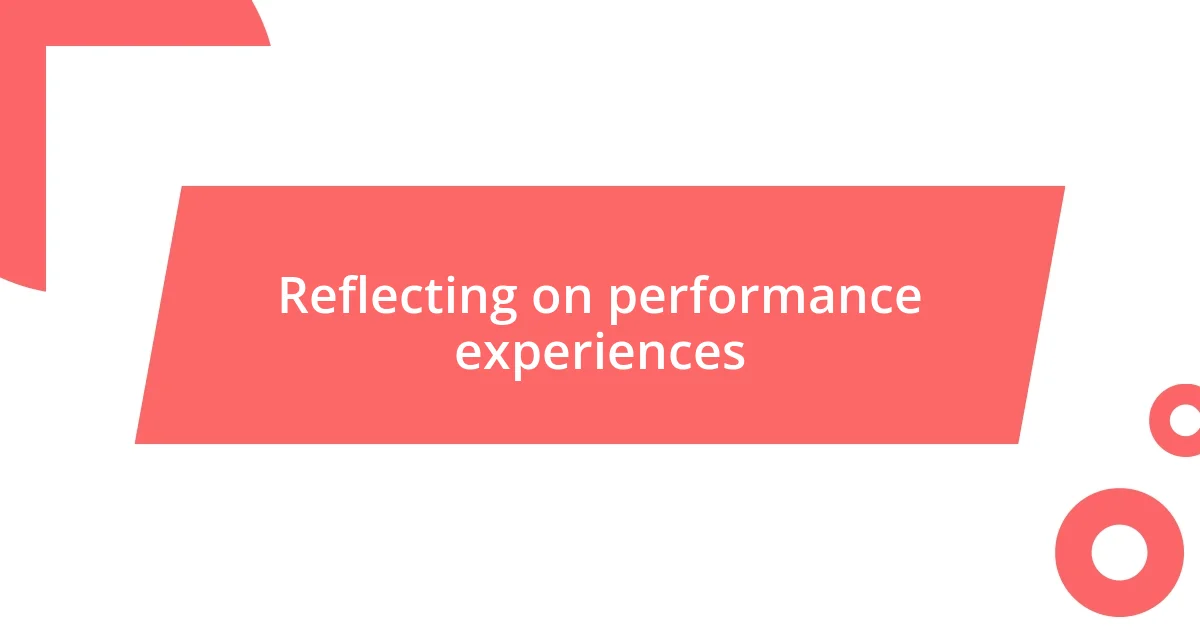Key takeaways:
- Improvisation requires emotional readiness and connectivity with fellow performers, emphasizing trust and the principle of “Yes, and…” for collaboration.
- Building stage confidence comes from accepting vulnerability, practicing regularly, and creating supportive team dynamics to thrive amidst uncertainty.
- Engaging with the audience and embracing unpredictability, including mishaps, can elevate performances and foster deeper connections.

Understanding improvisation concepts
Improvisation is not just about spontaneity; it’s about being present and deeply attuned to your surroundings. I remember my first time on stage, feeling the electric buzz in the air as my heart raced. In that moment, I realized that every sound, every shift in the audience’s energy influenced my next move. This awareness is crucial—how often do we let opportunities slip by because we’re too wrapped up in our own preparation?
At its core, improvisation is built on trust—trust in yourself and your fellow performers. During a particularly memorable performance, a teammate missed a cue, and instead of panicking, we played off each other’s energy. That moment taught me that embracing the unknown can lead to some of the most genuine and unforgettable experiences. Isn’t it fascinating how a small moment of uncertainty can turn into pure magic on stage?
Another fundamental aspect is the concept of “Yes, and…” This simple phrase encourages collaboration and acceptance of ideas. I’ve found that engaging with others’ suggestions opens the door to endless possibilities. Think about it: how many great ideas have you passed up simply because you were afraid to build on someone else’s thoughts? Embracing this mindset has transformed the way I approach not just improvisation, but creativity in all aspects of my life.

Preparing for an improv performance
Preparing for an improv performance requires more than just an open mind; it demands an emotional readiness that comes from practice and preparation. I recall spending hours with my fellow performers just engaging in warm-up games. These exercises not only loosened us up, but they also fostered a deeper connection among the group. When you’re on stage, that bond becomes a lifeline, allowing us to react and adapt to whatever unfolds.
Here are some tips I’ve found helpful for gearing up before the show:
- Warm-up your body and voice with physical exercises and vocal exercises to enhance your presence.
- Engage in games that encourage spontaneity, such as word association or character building.
- Discuss potential scenes or themes with your team to create a shared mental space and boost confidence.
- Take a moment to center yourself—breathing deeply or visualizing success can quiet those pre-performance jitters.
- Remind yourself of the “Yes, and…” approach to keep the creative energy flowing, no matter what happens.
Each of these steps helps me build the mental and emotional scaffolding I need to thrive amidst the uncertainty of improv. I’ve learned that leaning into the energy of my team before stepping onto the stage makes all the difference when it’s time to perform.

Building confidence on stage
Building confidence on stage is an evolving journey that I’ve experienced firsthand. In my early days of performing, I often felt a wave of anxiety wash over me before stepping onto the stage. I remember a particular show where I was so jittery that I could barely feel my legs! But as I began to accept these nerves as part of the process rather than a hurdle, I discovered that channeling that energy transformed my performance. Recognizing that I was not alone in my feelings somehow made it easier—most performers contend with those same butterflies!
What I’ve come to realize is that confidence grows with each performance. After a few shows, I found my groove and didn’t just rely on my scripts but began to trust my instincts more. During a crucial moment in one particular performance, I made an unexpected decision that altered the entire scene. Instead of reacting with fear, I embraced it, which not only boosted my confidence but also energized the audience. Have you ever experienced a moment where taking a risk paid off, even if it seemed daunting at the time? That’s the beauty of improvisation; it teaches us that acting boldly can lead to rewarding outcomes.
As I look back, I can see the wisdom in creating a supportive environment. I’ve created rituals with my team, from group huddles to motivational cheers, which helped to lift our spirits before shows. When I feel the collective energy and enthusiasm of my fellow performers, it’s like a jolt of confidence. In moments of uncertainty, I lean on this camaraderie. It’s remarkable how the simple act of sharing our fears can build a solid foundation of support, empowering all of us to take center stage with confidence together.
| Experience | Effect on Confidence |
|---|---|
| Nervous before performances | Learned to channel anxiety into energy |
| Taking creative risks | Increased trust in instincts and boosted audience engagement |
| Team rituals | Fostered a supportive environment that enhanced confidence |

Techniques for effective improvisation
The cornerstone of effective improvisation lies in embracing the “Yes, and…” principle, which I often find myself repeating before stepping on stage. I remember a specific night when a fellow performer took a wild turn, completely altering the scene. Instead of resisting the change, I jumped in with my own twist, and that collective spontaneity spiraled into a side-splitting adventure. It’s moments like these that remind me how collaboration and acceptance can elevate a performance to unexpected heights.
Active listening is another essential technique I cherish. I recall during one improv session, I was so caught up in my own ideas that I missed a funny callback from a teammate. The moment flashed by, leaving me feeling disconnected and slightly embarrassed. Since then, I’ve learned that truly tuning in to what your fellow performers say creates a more cohesive and engaging scene. Have you ever felt like a scene is falling flat? I bet if you focus on your partners, you can recapture that magic together, just like I now strive to do.
Another technique I can’t stress enough is playing off the environment. I had a show in a park once, where the sounds of chirping birds and laughing kids became part of our performance. Instead of sticking rigidly to our script, incorporating those elements transformed the scene into an organic and lively experience. It’s fascinating how the world around us can spark creativity if we’re willing to adapt. What’s stopping you from weaving in your surroundings during your next improv session? You might just find that the real world brings a wealth of inspiration waiting to be tapped into.

Navigating audience interactions
When it comes to navigating audience interactions, I’ve learned that every moment is an opportunity to connect. One evening, I found myself on stage when a member of the audience shouted a witty remark right in the middle of a tense scene. Rather than ignoring it, I embraced the comment, skillfully weaving it into the dialogue. The laughter that erupted was electric, and I felt an instant bond with those watching. Have you ever noticed how a simple exchange can shift the energy in a room? It’s that lively interplay that transforms a performance into a shared experience.
I’ve also discovered that the art of improvisation thrives on audience feedback. Once, during a particularly quiet crowd, I started asking questions that invited responses. I was surprised by how much their enthusiasm grew, just from a few prompts! It reminded me that engaging the audience transforms you from a performer into a storyteller, creating moments that resonate with everyone present. Can you recall a time when a mere inquiry ignited excitement among listeners? For me, those interactions serve as poignant reminders of how participation enriches the performance.
Another aspect I relish is the unpredictability of audience reactions. I recall a performance where an audience member inadvertently spilled their drink, causing a ripple of laughter throughout the venue. Instead of allowing that hiccup to freeze me in my tracks, I made a quick quip about hydration being key in our improv antics, and the moment turned into a playful exchange. Every mishap can become a delightful part of the story we are telling together. How do you view interruptions on stage? I’ve learned to embrace them—they inject spontaneity and authenticity into our art, making every performance unique.

Reflecting on performance experiences
Reflecting on performance experiences is often a journey through a kaleidoscope of emotions. I vividly recall one night where everything seemed to go wrong—technical glitches and missed cues threatened to derail the show. But instead of panicking, I chose to laugh it off and acknowledge the chaos. The audience joined in, creating an atmosphere of unity and resilience that I can still feel today. Have you ever found strength in vulnerability like that? It’s a powerful reminder that a shared moment of imperfection can forge a deeper connection.
Another memorable performance taught me the value of self-reflection. After a particularly electrifying set, I sat backstage vibrating with adrenaline and replayed the night’s events in my mind. I realized how much I had grown as a performer just from hearing the audience’s reactions. That feedback sparked a sense of curiosity in me—what worked, what didn’t, and why? I still carry that inquisitiveness into every show, striving to leave no stone unturned in my pursuit of mastery. When was the last time you evaluated your performance? Those reflections can often lead to breakthrough moments.
Sometimes, it’s not just the performance itself, but the relationships built along the way that leave a lasting mark. I think back to one show filled with laughter, where a newly formed team came together seamlessly. They felt like family after just one hour, driven by a shared mission to bring joy. The experience solidified my belief that improvisation is as much about the connections we forge as it is about the art we create. Doesn’t it feel incredible when performance becomes a canvas to celebrate camaraderie? Those are the experiences I treasure most.

Tips for continuous improvement
Continuous improvement in improvisation is all about being open to learning from every performance. I remember a night when I stumbled over my lines, and instead of letting it shake my confidence, I embraced it with humor. I laughed it off, turned it into a funny moment, and later realized that acknowledging my slip-up not only entertained the audience but also taught me to embrace vulnerability on stage. When was the last time you turned a mistake into a memorable moment?
Another key to growing as an improviser is consistent practice with other performers. Each rehearsal can reveal new dynamics and techniques that I hadn’t considered before. I once practiced with a group that specialized in musical improv, which pushed me creatively in ways I had never imagined. The energy and spontaneity in their approach prompted me to step outside my comfort zone. Have you ever tried an improvisational style different from your own? Those experiences can lead to unexpected breakthroughs.
Additionally, seeking constructive feedback is invaluable. After a show, I often ask my fellow performers what moments resonated with them and what could use improvement. One evening, a teammate pointed out a subtle gesture that I had unintentionally overused. This insight was a game-changer for me. It helped refine my technique, and I noticed a marked change in how my audience connected with my performance. How do you seek feedback in your journey? Embracing honest evaluations can illuminate paths to enhancement you never thought possible.














